
MARTIALFORCE.COM
PRESENTS
AN INTERVIEW WITH
ERROL BENNETT SHIHAN

FEB / 2017
Hello everyone, my name is Eddie Morales and welcome to Martialforce.com online Martial Arts Magazine. Back in the 1960ís and 1970ís, the streets of New York City were filled with gang violence that spread across all five boroughs. It was a time of, survival of the fittest. Drugs on the streets were at their highest level in sales and thus, many lives were destroyed. Death was around every corner and juvenile delinquency was rampant. It was a time when you had to be determined to stand tall or be engulfed in the peer pressure that was constantly present. karate and Kungfu were beginning to flourish throughout the city and Martial Arts movies saturated the theaters. This interview is about a young man that did not give in to the pressures of life. He instead decided to begin a long journey of blood, sweat and discipline. His decision forged who he was to become in life. He has helped many along the way and the fire of his journey still burns passionately within his heart. This story begins in the Bronx N.Y. and the young man Iím writing about is Shihan Errol Bennett. Bennett paved a way throughout East Coast Karate history as one of the most determined, aggressive Karate practitioners and fighters of that time. His lineage is strong and his karate training to this day maintains a strength of truth and tradition. I knew of his reputation for many years and was honored that he accepted this interview. When I spoke with him on the phone I was impressed with his knowledge of history, tradition and current events in the Martial Arts community. We covered many topics in our conversation and I learned a few things as a result. I hope everyone enjoys this interview as much as we do here at Martialforce.com.
Eddie Morales
Martialforce.com
Online Magazine
Martialforce.com: Where were you born and where did you grow up?
SHIHAN ERROL BENNETT: I was born on the island of Jamaica and lived in Mandeville. My Mother, sister and I later moved to New York City
Martialforce.com: What is your current occupation?
SHIHAN ERROL BENNETT: Private body guard and security consultant as well as my lifeís passion, Martial Arts instructor.
Martialforce.com: What drew your attention to martial arts training?
SHIHAN ERROL BENNETT: After observing various Martial Arts experts practicing the movements and techniques of kata, I was amazed at their exceptional physical control and mental ability to focus.

SENSEI BENNETT BACK ROW STANDING THIRD FROM LEFT

SHIHAN BENNETT ON THE LEFT
Martialforce.com: Can you tell our readers about your teachers?
SHIHAN ERROL BENNETT: In the early 1960ís I was introduced to the Martial Arts by my older brother Loxley Bennett. After moving to New York City, I joined the Shotokan Karate Club founded by Buddy McRae. The instructors were Sensei Hannibal, Sensei Rodriguez, Sensei Buckley and Sensei Musawwir (formerly known as Monroe Marrow). Sensei Musawwir was a top fighter who studied Shotokan, Goju ryu, Tai chi and Yun mu Kwan, which is one of the original five styles or "Kwans" that arose in Korea after World War II. It mirrored the systems of Karate practiced in Japan and Okinawa. Sensei Musawwir had the ability to demonstrate each art in its purest form.
Years later, after leaving the Shotokan karate club in 1969, I trained on my own until the late 1970's. Within that time, I visited The Melrose Dojo in California and spoke to, Richard Verdugo who was the manager at that time. Verdugo told me Master Tsutomu Oshima was away leading special training. I kept coming back until one Sunday morning while staying in Beverly Hills I decided to drive to the dojo and saw Mr. Oshima teaching a brown belt class. Throughout the years, I had observed most of the top Shotokan instructors but when I saw Mr. Oshima I realized he was on a different level mentally, spiritually and physically. I asked Mr. Oshima permission to join Shotokan Karate of America.
Once I was accepted I had the opportunity to practice with many high level seniors such as Caylor Adkins, Ken Osborne, Don Depree, Lee Muhl, Daniel Chelma, Marion Taylor, Frank Cole, Ron Thom, Norman Welch, Greg Scott, Tom Muzila, Yasunori ono, Jim Sagawa, Sadaharu Honda ,Randy Mcclure, Samir Abboud Eli Cohen ,Mark Kohagura ,Bruce Kanegai ,Dave Lechuga ,John Beltram, Deke Keasbey, Jerome Williams ,Aja al Fasah, Daniel Mcsweeney, Virgil Mcclain Frank Lee, Louis Gottlieb, Jeff Klein, Ron Wafer, Roland Duval,Ray Berry, Larry Lazarus, Jose Rivera, Kei Teramoto, and John Teramoto. These men made enormous contributions to the history of martial arts in America and are exceptional human beings.


Martialforce.com: In general, what do you feel is gained by the practice of Martial Arts?
SHIHAN ERROL BENNETT: The practice of Martial Arts requires a set of principles you must live by, such as self-control, discipline, respect and a clear mind to make the right choices. It lends itself to a spirit of wellness and strength, which in turn keeps drugs and negative influences out of your life, while you seek to become a better person. Its practice incorporates the mind, body and spirit to reach a sense of unity as all three are utilized in the training of Karate.
Martialforce.com: Who has been your biggest influence in martial arts and through your life?
SHIHAN ERROL BENNETT: Master Tsutomu Oshima, the last direct student of Shotokan Karate Founder Master Gichin Funakoshi who introduced karate to the Japanese mainland in 1922. Mr. Tsutomu Oshima studied Shotokan Karate with Funakoshi while attending Waseda University in Tokyo, Japan (1948-1953.) At approximately 1955 after leaving the Waseda University he traveled to America to continue his studies. He settled in Southern California where he was to become the first person to teach Shotokan Karate in the United States. In 2016 his students from all over the world came to Santa Barbara California to celebrate the 60th year of S.K.A ( Shotokan Karate of America). We continue our commitment and dedication to preserving the teachings of Master Oshima. In my opinion he is a rare gem of the Martial arts world with a deep understanding of Budo.

MASTER TSUTOMU OSHIMA

Martialforce.com: Do you believe that the practice of kata (prearranged movements), is an important aspect of training in karate and if so why?
SHIHAN ERROL BENNETT: Kata is the essence of karate-do (The way of the empty hand). When you practice thousands of repetitions you begin to realize there are countless applications of techniques that the masters developed within the kata. The more you practice and develop your stances, breathing rhythm and timing, the better you will understand as you reach a point of embodiment.
When you are watching The Ultimate Fighting Championship, you can see all the blocks strikes and throws which are all in our katas. Kata is not a dance or theatrical movements; it must be realistic. All techniques must be practiced with a sense of combat. Your mindset must be strong and positive in each movement isolating time and place in different scenarios. You must visualize an actual opponent as you strike with tenacity and control. In my opinion, Kata is beneficial, when itís practiced correctly.



TRAPPING BLOCKS FROM KATA

Martialforce.com: What in your opinion defines a good Martial Arts practitioner?
SHIHAN ERROL BENNETT: One who practices with a realistic view of execution of technique with a passion for Kihon (basics), as well as a spirit of continuous learning.
If a student goes through the practice of karate-do without being challenged in a controlled environment or changes rank quickly, they will become instructors who were unchallenged and will not be able to defend themselves from a street fighter.
You cannot fool yourself, a student must get over the fear of getting hit, grabbed or thrown. Karate-do is not a game, there is a certain amount of contact that is required. The training must be realistic but at the same time we must be careful not to injure our training partner.

Martialforce.com: Can you give our readers your definition of a good instructor?
SHIHAN ERROL BENNETT: Knowledge is key, lineage is paramount. Who is your instructorís instructor? Are you teaching authentic martial arts or something you made up? One of the most important factors is, the instructor must maintain his or her physical practice. All instructors must lead by example! They must have the ability to demonstrate and explain every facet of training to their students. A good instructor is fair to all his or her students. They must teach them to be well rounded Karateka and instructors in the future as well as productive citizens.
Martialforce.com: You taught Karate in the Bronx in a time that was rough. My question is, did anyone ever visit your dojo and challenge you?
SHIHAN ERROL BENNETT: Occasionally, a rogue black belt or two would stop by and want to fight me. I would give them a waiver and indemnification clause form. I ask them to sign it, get it notarized and bring it back. I would advise them the Hospital is a half mile away. Once we had that conversation, they bowed and left quickly.
Martialforce.com: Do you believe that tournament participation is a necessary practice and if so why or why not?
SHIHAN ERROL BENNETT: Before answering your question, I will explain its history. Tournament karate did not exist anywhere in the world until 1952 when one of Master Funakoshiís most gifted students Tsutomu Oshima Shihan created a set of rules using a referee, side judges and Shobu Ippon point system to conduct tournament matches. In 1967 Master Ohshima brought the first United States team to Japan to compete, train and demonstrate. Traditional karate will now be included in the 2020 Olympics in Tokyo. We all owe a great deal of gratitude to Master Ohshima for his vision.
In answer to your question, it is a necessity. Nothing brings more excitement to a karate exhibition or celebration than the team and individual Jiyu Kumite matches (Free sparring). After months of training and preparation you now face the unknown opponent. It is a test of mind, body, reaction and timing. Knowing one moment of mental lapse in a match will cost you. The anticipation of competition brings your mental posture to its highest point in training. You may have the largest karate group in the world but if you donít have strong fighters in the competitive arena, no one will respect you.


Martialforce.com: You were a successful tournament competitor and our research shows you were feared by most competitors. My question is, what would you say was your formula for success?
SHIHAN ERROL BENNETT: Growing up in New York city in the 1960ís & 70ís just walking down the street, going to school, to a park, to the store, crossing neighborhoods, going to work or a tournament, you would get attacked. There was always someone testing you or just trying to take what you owned with absolutely no regard for your life. It was always a quest to avoid trouble but sometimes you had to defend yourself and your self-defense had to work for you to survive. This realistic combat mentality carried over to the tournaments which in turn made New York City a tough place to compete. This is the environment I came up in. Many fighters would avoid the New York tournaments. New York had many strong dojos (Karate training halls) during this golden age, many of the master instructors had top fighters in their dojoís.
Furthermore, in my opinion, based on my years of experience, there is no magic formula or shortcuts to achieve anything of value in life, hard training is the prerequisite. I would practice a minimum of three hours per session, spend equal time on kihon (Basics), kata (Prearranged movements) and kumite (Sparring), bag work, speed drills, jump rope, cross country running, makiwara training (Striking pad), push-ups and sit ups.
I would visit as many dojos as I could on the east coast and ask the instructors if I could spar with the black belts. If there were three or ten black belts I face each one back to back. Facing many fighters of different styles and technique helped me research into Jiyu kumite in regards to tactical efficiency, timing of technique, ranges of combat and it strengthened my mental posture and or resourcefulness.

Martialforce.com: What do you feel are the main differences if any, in tournaments of the past in comparison to the present?
SHIHAN ERROL BENNETT: Tournaments of the past were by invitation only. You could only attend if your instructorís dojo was invited and they were well organized. Eliminations throughout the day and at night there were exhibitions and the Kata / Kumite grand championship. The black belts fought hard and showed each other mutual respect at the end of the match. Thomas La Puppet and Toyotaro Miyazaki were prime examples of good sportsmanship. They had the satisfaction of knowing they adjusted techniques during the fight to win without the help of a coach.
Martialforce.com: Can you list the names of some of the toughest fighters you ever faced?
SHIHAN ERROL BENNETT: Hawk Frazier, Ralph Mitchell, Ralph Gastiburo, Bradford Gonzales, Little John Davis, Rabbit Goodman, Larry Kelly, Earl Thompson, Donnie Collins, Jimmy Santiago, Wild Cat Molina, Fred Miller, Mychal " Look up" Sledge, Mark " Speedy" Wilson, Sam Mcgee, Haisan Kaleak, Ron Van Clief, Eugene Floyd, Dan Anderson, Ron Henderson, Sheldon Wilkens, George Asckar, Shabaz Beecher, Sabu Lewis, David Washington, Teddy Wilson, Jeff Smith, Michael Robinson, Doc Utsey, Lamar Thorton, Herb Wiles, Andre Mason, The Black Karate Federation fighters from California, He ll Cho AKA the Korean national champion. From Japan, Okomoto and Nagayasu Ogasawara. From France, Elias Abi Chaccra, Thierry Pirretz and Michel Coutant.
BENNETT VS FRED MILLER
BENNETT VS NAGAYASU OF JAPAN

S. HENRY CHOíS TOURNAMENT
RICARDO PICKENS AND SHIHAN BENNETT
Martialforce.com: Can you tell our readers about any fights you had during your time in the competitive arena that stand out for you?
SHIHAN ERROL BENNETT: I have faced many great champions from taekwondo, Goju Ryu, Shotokan, Wado Ryu, Kempo, Shito Ryu and Kyokushin Kai, open and Shobu Ippon. I had some tough matches against the Caddle brothers, The Wilder twins and Hawk Fraizer from Master George Cofieldís Tong Dojo. I also had some marathon matches with Fred Miller, battling the Korean National champion Hee ll Cho at Madison Square Garden, battling toe to toe wth Nagayasu of Japan and the mental chess battles with Michel Coutant, Thierry Pirretz and Elias Abi Chaccra from France.

BENNETT VS TEDDY WILSON

Martialforce.com: Can you list some of the toughest Kata competitors you ever faced?
SHIHAN ERROL BENNETT: Michael Robinson, William Oliver, Melvin and Calvin Wilder, Fred Miller, V. Romo Requero, Freddy Lopez, George Crayton, Abdul Mutakabbir, Rocky Direco, Kevin Thompson, Terry Maccarone, Alex (Plus One) Steinberg, Jim Smith and Robert Sugar Crosson.
Martialforce.com: You have taught Karate for many years and currently continue a rigorous schedule of teaching. My question is, what motivates you to get up, go to your Dojo and teach?
SHIHAN ERROL BENNETT: Growing up in any major city, many of our young people are at risk. There are not enough recreation and community centers, art crafts, music, vocational schools or libraries to help their minds stay occupied and grow in a positive direction.
I began teaching Martial Arts and used it as a tool to keep the neighborhood kids off the streets. My hopes were that the hard Karate training and the discipline gained would keep them away from drugs, alcohol and gangs, which were prominent in every street corner and boroughs in New York City and more specifically the Bronx, where I was located.
I wanted them to be in a better mindset to make good sound choices throughout their lives and equip them to handle the peer pressure they faced daily. Because of their training and dedication, many students realized their dreams and continue to do so. I taught and continue to teach that the key to success is hard work and you alone are responsible for your success or failures.
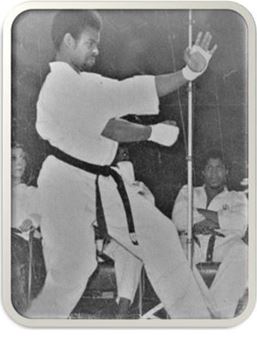
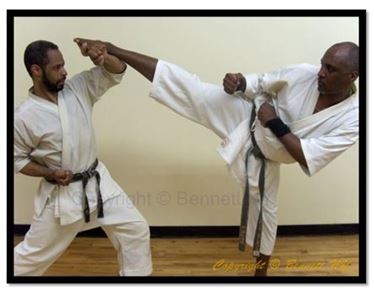
SENSEI BENNETT STUDENTS, BARRY BROOKS
AND PAUL SEQUENCE FERGUSON
Martialforce.com: Your students dominated the tournament scene back in the 1970 / 80ís. Did you train them with the same tenacity that you yourself trained?
SHIHAN ERROL BENNETT: Yes, their training was no different than the way I was taught. I lead by example, so If I had my students do one thousand kicks or punches, I lead the way through every technique and repetition. The training sessions were hard and frequent, sometimes twice a day. The endurance it took to get through those sessions developed strength, focus and tenacity. It challenged your heart, soul and spirit. These training sessions gave you the, ďI can do anything mindset.Ē
I maintained a curfew restriction on parties and social events as well. This training and sacrifice laid the foundation for strong Karate practitioners, making my students a force to be reckoned with. My students of the past and present won and continue to win at major local United States and international events in France, Israel, Germany, Switzerland, the Dominican Republic and South Africa to name a few. Because of their dedication to the practice of Karate, they grew to be strong practitioners as well as contributing adults in society. Iím very proud of all their accomplishments.


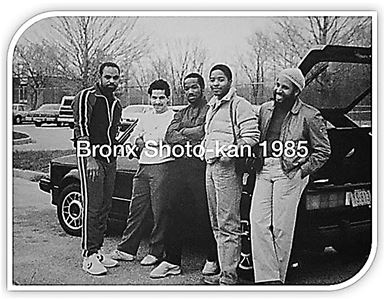
SENSEI RYON RICHARDSON

PAUL SEQUENCE FERGUSON AND SENSEI BENNETT
Martialforce.com: Can you name some of your students past and present so that we can acknowledge their accomplishments?
SHIHAN ERROL BENNETT: Ronald and Gesner Herard, Russell Turiak, Rahiem Abdur, Lori Derhagpioan, Doug Jones, Glover Glenn, Franklin Williams, Walter Kong, Ricardo Pickens, Earl Razor, Paul Bent,
Barry Brooks, Joe Barnes, Baron Clark, Matty Melisi, Mike Murphy, Qasiem Astwood, Maurice Baker, Byron Snowball, Paul Sequence Ferguson, James Outlaw, Clark Marquez, Michael Jay Jackson, Billy
Beason, Skeeter Mccullough, B.O Williams, Paul W. Smith, Lee Smith, Lori George, Steve Macagnone, James Mcgrath, Keith Smith, Ron Kinloch, Sampson Crosby, Hilde Free, Wakki Smith, Norman
Smith, Kofi Samuels, Joel Francis, Lloyd Mosley Jr, Kevin Clark, Elias Cortez, Jeff Maldonado, Phil Salanto, Michael Samuels, Steve Thompson, Jill Ganasi, Michelle Patterson, Anna Sheila Paul, Hilliary
Frank, Ron Frank, Sam Diaz Jr, Sam Diaz III, Ryon Richards, Armando Bennett, Robert Bird, Gary Domingo, Jack Smith, Kelvin Murph, Angel Diaz, Milton Sweet, Richard Harmon ,Mervin Calvery,
George Blanco, Derrick Williams ,Dutchy Williams, Michael jai White, Carl Smith, Dennis Thorn, Yvonne Thorne, Junior Ortiz, Elaine Jackson, Zay Flaherty, Chase Bennett.

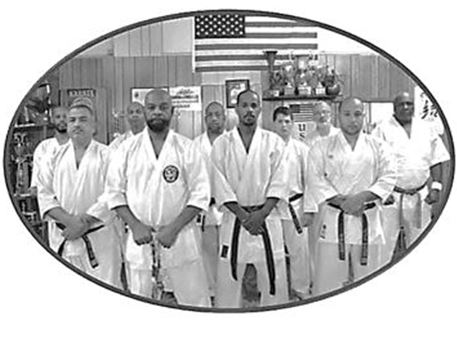

SENSEI BENNETT AND STUDENT
MICHAEL JAY JACKSON
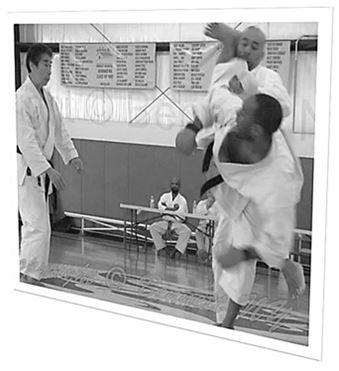
SHIHAN BENNETTíS SON, ARMANDO BENNETT
Martialforce.com: We spoke of your competitive time in the fighting arena as a black belt. My question is, did you compete as a white or color belt and can you tell our readers about your experience back then?
SHIHAN ERROL BENNETT: My introduction to Jiyu Kumite began with me facing black belts in sparring sessions. At that time, no one told you to put your hands up. If your stance was weak, you got swept on the floor. If your face or body was unprotected, you got hit. There was no theory or explanation, you just learned to survive. Because of my training and the experience I gained, I was always more advanced than most of the competitors in the white belt and brown belt divisions at tournaments.
Martialforce.com: What tournaments did you most enjoy as far Budo and organization?
SHIHAN ERROL BENNETT: The annual Nisei week tournament and exhibition hosted by Shotokan Karate of America, the New York International open hosted by Luis Ruiz and The Traditional Tournament hosted by Baxter, Barksdale, Adler, Lueng, Hiraldo, Falcon, Asckar and Ed Brown.
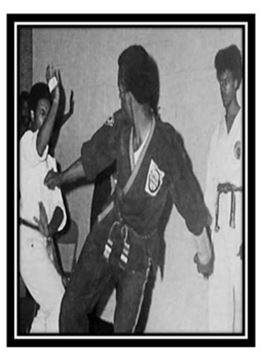
SHIHAN BENNETT IN WHITE UNIFORM
AS PHIL MCRAE TO THE RIGHT, LOOKS ON

BENNETT ON RIGHT VS BROWN ON LEFT
REFEREE AARON BANKS IN THE CENTER
Martialforce.com: Back in the early days of competition there was an air of respect for all judges and referees in tournaments. Excluding the traditional tournament competition, currently, you go to a tournament and see competitors disrespecting higher ranks, teachers and judges. It seems like the word respect is rare and most of the time, nonexistent among Martial Arts practitioners. What are your thoughts on this lack of respect?
SHIHAN ERROL BENNETT: First and foremost, when addressing this problem, we should be very careful when describing these competitors as martial artist. The study of martial arts is about discipline, respect, self-control and honor. It is important for competitors and spectators to know and follow the rules. The referees and judges must be trained, alert, fair and competent when making any decisions.
All spectators, family and friends must be away from the competitive area. As in any major sporting event, crowd control is important. The promoter should not be more concerned with monetary profit and must not sacrifice the integrity of the tournament. When a competitor maliciously injures another or parents and anyone associated with them become disruptive, the promoter must not hesitate to ban or suspend them. Coaching is now becoming a problem with the antics and temper tantrums displayed when all goes against their students. We cannot reward bad behavior; this is a recipe for disaster.

BENNETT AND JOSE JORDAN
Martialforce.com: What do you feel was or is the highlight accomplishment of your life?
SHIHAN ERROL BENNETT: Without hesitation, I would have to say, one of the highlights and accomplishments was working in the entertainment industry as a bodyguard for Diana Ross as well as traveling and visiting Motown. I met some incredibly talented musicians, singers, producers and entertainers such as, Barry Gordy, Quincy Jones, Stevie Wonder, Smokey Robinson, Lionel Richie, Michael Jackson and the Jacksons, David Ruffin of The Temptations as well as The Isley brothers. It was a great experience and I was able to observe their disciple and commitment to their craft.
I attended President Bill Clintons inauguration with Diana Ross and family at the Lincoln memorial along with a list of whoís who in the entertainment industry. Another accomplishment is having the title of Sensei (Teacher) and Father and being fortunate to have a caring family and seeing my students become successful in their personal and professional lives, which means the world to me.
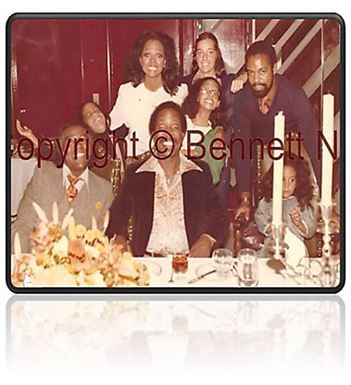
Martialforce.com: You mentioned you worked with Diana Ross as her bodyguard. How did you meet and begin to work for her?
SHIHAN ERROL BENNETT: Many of my friends were involved in music. I began to work as a DJ (Disc Jockey) in many clubs. One evening while I was working, a gentleman by the name of George Sewitt, who was the former road manager for the band Kiss, approached me and told me Diana Ross was looking for some personal security to travel on tour with her. We had a meeting at the Sherry Netherlands Hotel in New York in the late 1970ís. I began working for Diana Ross shortly after as a personal bodyguard, which I continued for approximately a twenty-year period. Most people see and only know the entertainment side of her. I was honored to be able to see a different side to her. At that time, all her children, Rhonda, Tracy and Chudney were young. Miss Ross was a dedicated and loving Mother. She was hard working and well organized in all aspects of her life. Everything from getting her children ready for school to being punctual in her business meetings and rehearsals. She was the epitome of a professional in every sense of the word and surrounded herself with great people such as Armondo Hurley, Arthur Fowles, Geneva and Jeanne OíConnor.


Martialforce.com: You fought in a bare knuckle all out no holds barred tournament that was given by the late Fred Hamilton back in the 1970s in New York City. It was basically the same rules as the U.F.C when it began which was no rules. You were the only fighter to score knockouts with kicks. Are there any thoughts that you could share about that tournament regarding competitors, level of competition or any fight that stands out in your mind?
SHIHAN ERROL BENNETT: In regards to my training and preparation. I always trained hard in my Karate so mentally and physically I was prepared. I also supplemented my training with Judo, Boxing and wrestling. These are skills that are needed to enter this type of competition. Fred Hamiltonís bare knuckle tournament was the first event of its kind in the Northeast to become the focus of National attention in the mid 1970ís. Sensei Hamilton was a pioneer and established something that would flourish throughout the years. There were similar tournament held in the New Jersey and Chinatown in Manhattan that did not get exposure.
In regards to its participation, you had to have a heightened sense of awareness that could only be developed through hard dedicated training because there were absolutely no rules. The competition was held on wooden floors, no mats, no hand or foot protection just bare knuckles and feet. The eyes, groin, throat, knees and ankles were all targets. If you knocked your opponent on the ground and mounted him they would attack your eyes or any target in range with no restriction. If you placed someone in a headlock they would attempt to escape by biting. The fighters back then such as, Ralph Mitchell, David Wells, Happy Crump, Fred Miller, Dennis Davis, Tayari Casel, Earl Thompson, Paul Vizzio, Jerry Stewart are considered some of the pioneers of bare knuckle, no rules in that region and time.

ERROL BENNETT AND FRED MILLER


Martialforce.com: You mentioned Judo, Boxing and wrestling in regards to preparation for the bare-knuckle event. My question is, do you believe that cross training is valuable in general or did you just cross - train for these type of events?
SHIHAN ERROL BENNETT: In my opinion, cross-training is valuable in general. I have researched the origins of martial arts dating back to Egypt, Africa, Greece, India, China, Okinawa and Japan and realize the practice of all the arts required a different pattern of breathing and muscle endurance. With cross training, you can isolate the main muscle groups such as shoulders, abdominals, quadriceps, pectorals, Trapezius, lumbar, gluteus and oblique. To improve performance many of todayís athletes and Karateka are involved in plyometrics training and many different forms of cross training.


Martialforce.com: Can you give advice to any Shotokan practitioner or Martial Artist in general reading this interview, in regards to their training?
SHIHAN ERROL BENNETT: As practitioners of the martial arts we must be forever indebted to the art. It has given us a sense of purpose, values, health, confidence and self-esteem. In my opinion, It is important that we preserve the tradition of the founding masters and have respect for your instructor, who takes time away from themselves and their families to teach and impart their knowledge and experience to you. In regards to the technical level, equal effort must be given when practicing kihon, kata and kumite.
We must encourage, train and prepare our students along this long journey even though at times they may not see the results right away they learn that it is a journey. Personally, I am never satisfied with my practice I always believe there is more to learn and always room for improvement.
Martialforce.com: If you could go back in time and change anything in your life, what would that change be?
SHIHAN ERROL BENNETT: I have a great appreciation for all the people I have met from all parts of the world. I think everyone has a message and purpose, we just must look closely and listen. We are who we are but we must try to make the world a better place in the present and future.
On a personal level, I wouldnít change anything because every experience whether negative or positive made me who I am. On a wider scope, the change that I would like to see is peace and universal understanding.
Martialforce.com: We here at Martialforce.com would like to thank you for taking the time to do this interview. We wish you the best in all current and future endeavors, thank you!
SHIHAN ERROL BENNETT: I would like to thank you, Eddie Morales personally for letting me share my thoughts and experiences.
SPECIAL THANKS TO PAUL SEQUENCE FERGUSON FOR PHOTOGRAPHS, VIDEO AND RESEARCH ASSISTANCE
TO MARTIALFORCE.COM